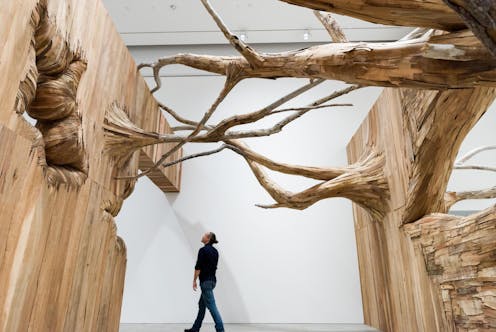how we revived these stories with new myths, new media and new quirks
- Written by Wes Hill, Associate Professor, art history and visual culture, Southern Cross University

Fairy Tales, the latest exhibition at Queensland Art Gallery | Gallery of Modern Art (QAGOMA), gives off the pleasurable hum of remix culture, artists riffing on a core theme in numerous ways.
Overseen by the gallery’s cinematheque curator Amanda Slack-Smith, Fairy Tales focuses on how artists, designers and filmmakers have taken inspiration from fantasy motifs, adapting the fairy tale vocabulary of extremes (light and dark, good and evil, rich and poor) to their own artistic needs.
Based in handed-down oral traditions, fairy tales share characteristics with all manner of fables, folk stories and mythological narratives throughout the world.
These stories, which were initially rarely intended for children (yet featured them as central characters in easy-to-understand plots), made their way into print from the 17th century.
After the coining of the word “folklore” in 1846[1], colonisation, advertising and the international spread of mass culture drove folklorists and creatives to praise the authenticity of localised oral traditions.
This seductively designed show at QAGOMA makes clear that, rather than fairy tales being simply preserved, the modern age revived them with new myths, new media and new individualistic quirks, from Hans Christian Andersen to Walt Disney and beyond.
Creatures in the night
Brazilian artist Henrique Oliveira sets the mood of the exhibition brilliantly with his gnarled and twisted woodland, Corupira (2023).
The sculpture builds slowly as you enter the corridors of the space and culminates in a meeting of massive tree branches that have burst through the gallery walls. Oliveira’s title refers to a Brazilian folk story about red-haired satyr-like creatures[2] who, living in the Amazon forest, deceive hunters and loggers from the shadows, killing them – or at least putting any potential coloniser off course.
It is a great opener to the show because it metaphorically turns viewers into fairy tale wanderers, and artists into tricksters and spell-makers.
Oliveira’s work chimes perfectly with The Nightwatch (2004) by Belgian artist Francis Alÿs, consisting of surveillance video footage of a fox the artist released into London’s National Portrait Gallery (with the gallery’s permission) during the night. Alÿs’s fox continues the fairy tale tradition of depicting forest animals as actively engaging with human societies.
Alÿs self-consciously titled his work after a 17th century painting by Rembrandt van Rijn[3] in which citizens are depicted serving as defenders and official volunteers for their city. Alÿs might be suggesting the contemporary artist is like a public servant whose job, like the fox in the video, is to intrude on the prized traditions supported by museums.
Australian artist Abdul Abdullah’s provocative photograph Troubling the Margins (from the Interloper series) (2022) follows a similar idea. Abdullah literally shows himself as a fox in a henhouse.
The artist-as-fox smiles maliciously at the viewer as if saying to the art world: “I can’t believe you let me in here.”
Read more: The amazing NGV Triennial 2023 makes us question our world and forces us to see it differently[4]
Uncanny images
One of many terrific sculptural works in the exhibition, Jana Sterbak’s Inside (1990) is an empty glass coffin seemingly pregnant with a smaller mirrored coffin inside.
A reversed imagining of life in death, the piece responds to the many glass coffins in fairy and folk tales (such as Sleeping Beauty, Snow White and the Grimm’s Brothers The Glass Coffin), exploring the uncanny idea of death being put on permanent display for the living.
It’s not a coffin but a caravan in Patricia Piccinini’s The Couple (2018), where two realistically rendered hybrid human-animal lovers are frozen in a serene moment cuddling on a fold-out bed, their clawed feet sticking out from under the sheets.
Piccinini’s works often centre on hyperreal figures that look genetically altered. These sculptures are at their most interesting when they make viewers aware of themselves. I felt stupid for it, but I couldn’t help feeling guilty for gawking too long at the sweet-looking couple’s physical deformations.
Projected behind a huge semi-transparent curtain, an exquisitely staged installation of Jean Cocteau’s 1946 film Beauty and the Beast is situated in relation to costumes and props from its production. This and other displays of material from fairy-tale-inspired films Where the Wild Things Are (2009) and The Labyrinth (1986) are among the most engaging cinema-themed pieces in the exhibition.
The capacity of anything to intrigue
In my 2015 publication[5] about the relationship between folk art and fine art, I argued art critics and art historians in the 19th and 20th centuries narrowly discussed oral traditions and amateur cultural creations in anthropological terms.
By their reasoning, these were artefacts that failed to live up to the special insights and feelings expected of fine art.
This school of thought is no longer the case. Fairy Tales is a good example of the recent expansion of art-history-based curating into larger visual culture frameworks. Clothing, relics, paintings, literary documents, installations, videos and filmic props now all cohabit the museum in non-hierarchical ways, staging not the inherent value of specific material so much as the capacity of anything to intrigue.
For a show about timeless human fears and fantasies, Fairy Tales may be curiously timely.
Fairy Tales is at QAGOMA, Brisbane, until April 28, 2024.
Read more: How the poetically-charged art of Tacita Dean gives its audience a moment for stillness and time[6]
References
- ^ “folklore” in 1846 (blogs.loc.gov)
- ^ red-haired satyr-like creatures (patagoniamonsters.blogspot.com)
- ^ Rembrandt van Rijn (www.rijksmuseum.nl)
- ^ The amazing NGV Triennial 2023 makes us question our world and forces us to see it differently (theconversation.com)
- ^ publication (www.routledge.com)
- ^ How the poetically-charged art of Tacita Dean gives its audience a moment for stillness and time (theconversation.com)

















